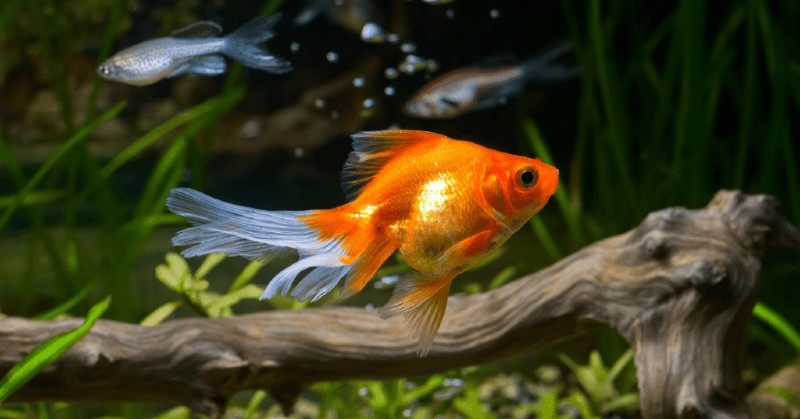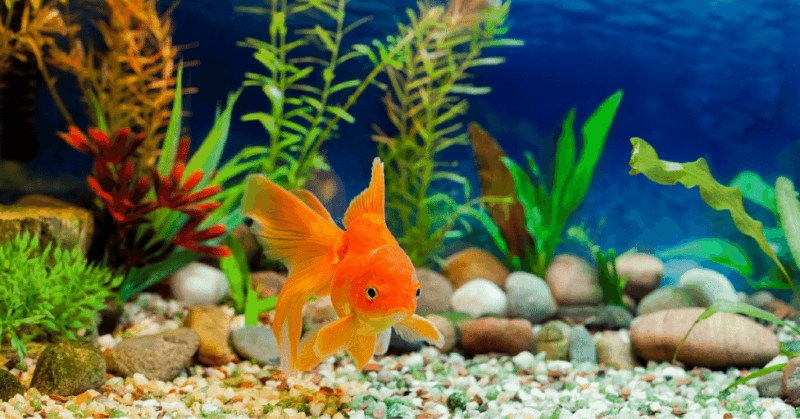Your goldfish turning black may be nothing to worry about, but it may also be a sign of disease that could kill your fish if left untreated.
Fortunately, there are steps you can take to first diagnose the issue, then act to ensure your goldfish lives a long and happy life.
My goldfish is turning black – what should I do?
1. Watch for odd behavior
If you see your goldfish rubbing its body against rocks or other ornaments in the tank it could be a sign of black spot disease – see below for more information.
2. Check for ammonia
If you notice any odd swimming patterns or labored breathing it could mean that ammonia poisoning is to blame for your fish’s change in color. Again, read on for the details that could save your fish’s life.
3. Move your fish to a quarantine tank
If there’s no ammonia present and your tank or pond has snails, you may want to quarantine your sick fish while you treat them. More on this below.
If you find ammonia, move all your fish to the quarantine tank to stop the exposure to ammonia-filled water. Your quarantine tank should be set up in advance and properly cycled, and will be home until the ammonia in your main tank is under control.
4. Remove any dead/decaying plant matter
If ammonia poisoning is the cause, look for decaying leaves and other plant matter which cause ammonia spikes as they
5. Vacuum your substrate/tank floor
Uneaten food and fish waste cause ammonia spikes because ammonia is release as part of the decomposition process. Get yourself a good gravel cleaner (like this one) and make sure you vacuum the tank floor regularly.
Ammonia Poisoning
High levels of ammonia in your fish tank can cause health issues and stress for your fish.
Just like how humans expel carbon dioxide as we breathe, fish constantly produce ammonia. This is unavoidable.
However, ammonia levels can also rise because of overfeeding and not keeping the tank clean. When the fish’s waste and excess food is not removed from the aquarium, it will start to rot and will then release high levels of ammonia into the water.
If ammonia levels get too high and your goldfish is turning black, they may have literally been burnt by the levels of ammonia in the water.
The black spots on their body and fins aren’t the burns themself. These black spots are a result of your fish starting to heal from the ammonia burns and will most likely stay on the fish forever due to the damage.
If you aren’t sure if ammonia poisoning is the reason for your goldfish turning black, keep an eye out for other signs. With high levels of ammonia, you may notice your fish:
- Gasping for air at the surface
- Lose their appetite
- Become very lethargic
- Start to show red or purple gills
To avoid ammonia poisoning, make sure to consistently remove excess waste in the tank, check ammonia levels frequently, and perform regular (weekly) water changes of 10-20%.
Is ammonia poisoning in fish contagious?
Ammonia poisoning isn’t contagious – it’s something your fish contracts from its environment rather than from other fish. However, if one of your fish has ammonia poisoning, there’s a real danger that the rest of the fish in the tank could also become ill, as they’re all swimming in the same water.
How to lower ammonia in a fish tank
Typically, you can lower ammonia in your tank by performing daily water changes of around 40% until the water parameters return to a safe level. To keep it down, make sure you have a good quality filter installed and change the filter media regularly, and invest in an air stone to increase the aeration of the water.
Read more:
*Note: one thing I hadn’t realized when I started keeping fish is that not all fish like having air stones in their tanks. Fish like bettas that naturally live in still, shallower waters may be stressed by too much movement in the water, but in this case, goldfish tend to love them (especially bigger ones and stronger swimmers).

If there’s no ammonia in my water, why is my goldfish turning black?
Once you eliminate ammonia poisoning, you’re either dealing with the dreaded black spot disease (rare but worrying) or another cause that’s nothing to stress about.
Black Spot Disease
Goldfish turning black due to contracting black spot disease is very rare for aquarium fish.
Your fish will only contract this disease if you have snails living in the same tank as them. Because of this, black spot disease is more commonly found in pond goldfish rather than fish kept in an enclosed aquarium.
This is due to snails in the pond, as well as bird droppings that find their way into the water.
These black spots come from a parasite that lays eggs, which turn into larvae that burrow into the skin of the fish.
To protect itself, the fish will start to form hard, black cysts around the larvae.
If you think this could be the cause of the black spots on your fish, keep an eye out for other unusual behavior.
For instance, your fish may start to flick and rub against surfaces in the aquarium due to being itchy and irritated.
So, if you notice your goldfish turning black and you keep snails in your aquarium, this could be the reason for the change in color.
To treat the disease, remove the snails immediately to break the parasite’s life cycle. After some time, your fish should recover.
Stress
We have discussed a few potential reasons for your goldfish turning black, but did you know that they may also turn black due to stress?
Fish can easily become stressed with sudden environmental changes like being shipped, moved, transferred to a new tank, or major changes to their original tank.
They may also become stressed if you recently introduced new fish or other animals to their tank. This stress can cause discoloration and will sometimes cause your goldfish to turn black.
If you think stress might be playing a role in your goldie’s color change, try not to worry. Your fish should recover after some time once it acclimates to the new changes.
Note: prolonged stress can also be fatal to fish, so make sure you research the ideal water parameters, tank size and swimming space, tankmates and water flow for your chosen species, and do all you can to create an environment that keeps them happy.
Blending into the Environment
One common cause for your goldfish turning black may be due to the environment in their fish tank.
All fish have different cells in their skin and some cells produce a black pigment called melanin. Placing your goldfish in an aquarium with a dark backdrop could cause your fish to produce more melanin and change colors to match their surroundings.
This can also happen if you have your aquarium near a dark-colored wall or if there are a lot of dark rocks and decorations in the tank.
If your goldfish is producing more melanin than normal, black patches will start to appear on their scales, fins, or tail.
Fortunately, this type of color change is a natural occurrence and is nothing to worry about. However, if you’re concerned about your goldfish turning black, try decorating your aquarium with a brightly colored background and objects.

Genetics
Another reason for your goldfish turning black could be due to its genetics.
For instance, many goldfish are considered “blended breeds”. This means they were not bred specifically to maintain certain qualities, including their orange or golden color.
So, unless you purchased your goldfish from a reputable breeder, there is a chance you have one of these blended breeds. In this case, you may start to see color changes in your fish over time.
While most of these genetic color changes occur within the first year of the goldfish’s life, you may notice the fish’s color gradually change as it gets older. These color changes include black spots and patches and often lighter patches as well.
A goldfish turning black due to genetics is no cause for concern and is nothing to worry about.
Will Black Spots on My Goldfish Go Away?
In some cases, yes. If your fish is turning black due to natural causes, genetics, or ammonia burns, your goldfish may remain black forever. However, in other cases, they may turn back to their original orange-gold color.
For example, if your fish is turning black due to its environment, you can remove the dark background or decorations and your fish will most likely return to its orange coloring.
How To Prevent Your Goldfish From Turning Black
Now that you know some common reasons for your goldfish turning black, it’s important to take preventive steps to avoid it happening again.
Here are some steps you can take to avoid your goldfish turning black in the future:
- Avoid overfeeding
- Consistently check ammonia levels in your aquarium
- Regularly remove excess food waste from the tank
- Check your tank’s filtration system to ensure it is working properly
- Clean your aquarium often and change the water
- Refrain from housing snails in the same tank as your goldfish
- Decorate your aquarium with brightly colored backgrounds and decorations (avoid using black or dark-colored backgrounds)
The Bottom Line
As you can see, the reason for your goldfish turning black isn’t always a cause for concern.
You may notice changes in color to your goldfish if it is matching its environment, is healing from ammonia burns, or if it is simply genetic changes.
It’s understandable to be concerned and ask why your beloved goldfish would be turning black, but most of the time, it’s just a natural occurrence.
As long as your fish friend is happy and healthy, try to appreciate the changes in their color.
After all, that’s what makes them unique and beautiful!
